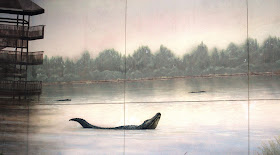Ivan Aivazovsky
Ivan Aivazovsky (July 29, 1817 – May 5, 1900) was an
Armenian-Russian world-renowned painter living and working in Crimea, most
famous for his seascapes, which constitute more than half of his paintings.
Aivazovsky is widely considered as one of the greatest seascape painters of all
time
Aivazovsky was deeply affected by the Hamidian massacres of
Armenians in Asia Minor in 1895, painting a number of works on the subject such
as "The Expulsion of the Turkish Ship," and "The Armenian
Massacres at Trevizond." and renouncing a medal which had been awarded to
him in İstanbul.
He spent his last years in Feodosia where he supplied the town
with water from his own estate, opened an art school, began the first
archaeological excavations in the region and built a historical museum. Due to
his efforts a commercial port was established at Feodosiya and linked to the
railway network. Aivasovsky died in Feodosiya in 1900.
Aivazovsky is best known for his seascapes and coastal
scenes. His technique and imagination in depicting the shimmering play of light
on the waves and seafoam is especially admired, and gives his seascapes a
romantic yet realistic quality that echoes the work of English watercolorist J.
M. W. Turner and Russian painter Sylvester Shchedrin.
Especially effective is his ability to depict diffuse
sunlight and moonlight, sometimes coming from behind clouds, sometimes coming
through a fog, with almost transparent layers of paint. A series of paintings
of naval battles painted in the 1840s brought his dramatic skills to the fore,
with the flames of burning ships reflected in water and clouds. He also painted
landscapes, including scenes of peasant life in Ukraine and city life in
İstanbul. Some critics have called his paintings from İstanbul Orientalist, and
others feel the hundreds of seascapes can be repetitive and melodramatic.
Aivazovsky became the most prolific Russian painter of his
time. Early in his career, he was elected a member of five Academies of Fine
Arts, including those of St. Petersburg (his Alma Mater). Rome, Florence,
Stuttgart and Amsterdam.
Aivazovsky left over 6,000 works at his death in 1900. The
funds earned during his successful career as an artist enabled him to open an
art school and gallery in his hometown of Feodosiya.
Ira Aldridge
Ira Aldridge was born on this date, July 24, in 1807. Aldridge spent his acting career in Europe, believing he would never work on stage in the United States because of the color of his skin. His acting transcended color barriers, however, and he played a spectrum of leading men throughout his career.
Grant Wood
Grant Wood is best known for his work American Gothic. The
painting shows a farmer standing beside his spinster daughter, figures modeled
by the artist's dentist and sister, Nan (1900-1990). The dentist, Dr. Byron
McKeeby (1867-1950) was from Cedar Rapids, Iowa. The woman is dressed in a
colonial print apron mimicking 19th century Americana and the couple are in the
traditional roles of men and women, the man's pitchfork symbolizing hard labor.
Gothic is one of the most famous paintings in American art and one
of the few images to reach the status of universally recognised cultural icon,
comparable to Leonardo da Vinci's Mona Lisa and Edvard Munch's The Scream.
It was first exhibited in 1930 at the Art Institute of Chicago,
where it is still located. Art critics who had favorable opinions about the
painting, such as Gertrude Stein and Christopher Morley, wrongly assumed the
painting was meant to be a satire of repression and narrow-mindedness of rural
small-town life since it was produced at a time when there was a trend toward
increasingly critical depictions of rural America, along the lines of Sherwood
Anderson's 1919 Winesburg, Ohio, Sinclair Lewis' 1920 Main Street, and Carl Van
Vechten's The Tattooed Countess in literature.
Wood's inspiration came from Eldon, southern Iowa, where a cottage
designed in the Gothic Revival style with an upper window in the shape of a
medieval pointed arch, provided the background and also the painting's title.
Wood decided to paint the house along with "the kind of people I fancied
should live in that house."
The house had once been a brothel.
Andrew Wyeth
I dream a lot. I do more painting when I'm not painting.
It's in the subconscious. Andrew Wyeth
I prefer winter and fall, when you feel the bone structure
of the landscape. Something waits beneath it; the whole story doesn't show. Andrew Wyeth
It's all in how you arrange the thing... the careful balance
of the design is the motion. Andrew
Wyeth
“One's art goes as far and as deep as one's love goes.” Andrew Wyeth, Cushing, Maine
Physical vision
Physical vision is responsible for nearly everything in art,
not the power to see but the way to see. It is the eye perfect or the eye
defective that determines the kind of thing seen and how one sees it." Marsden Hartley
la rue mosnier aux drapeaux






















